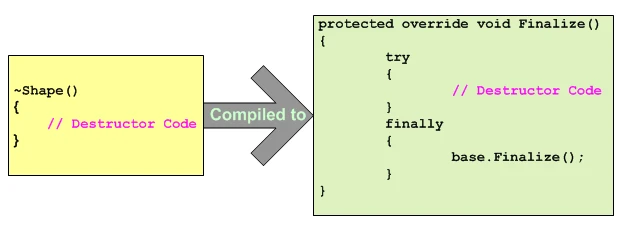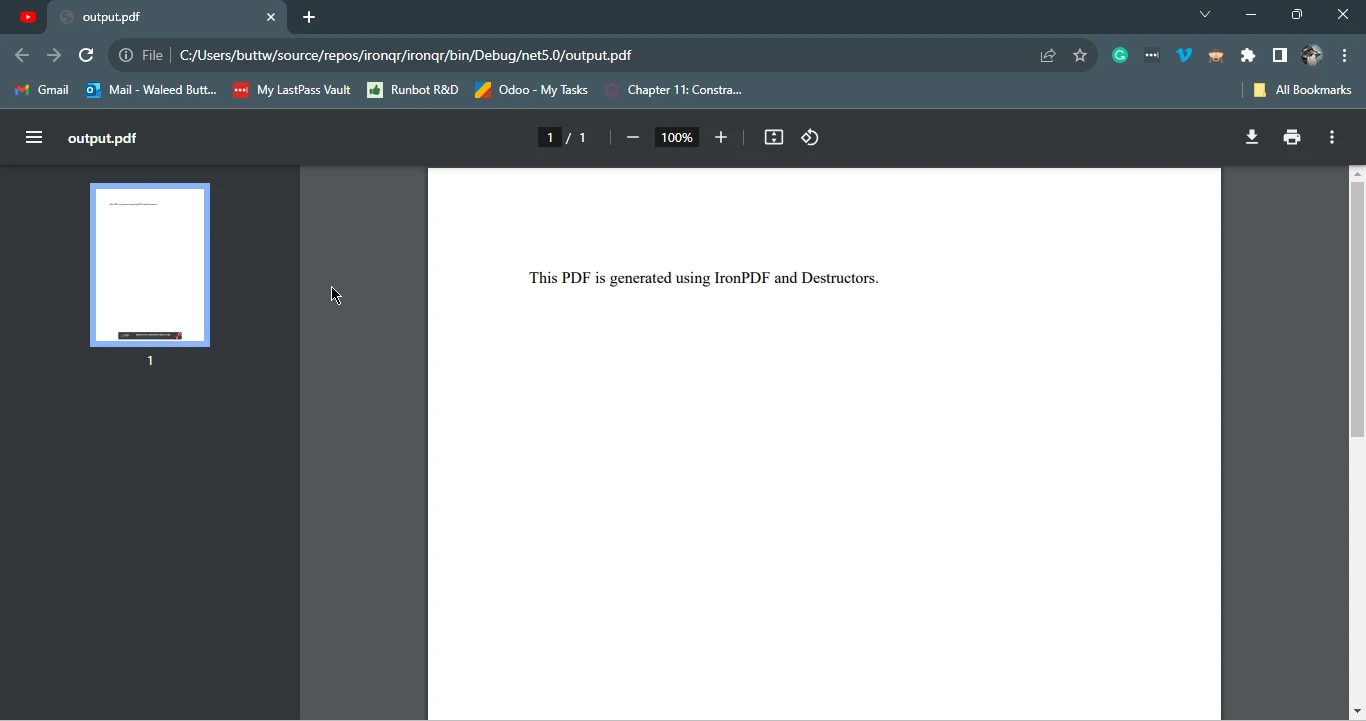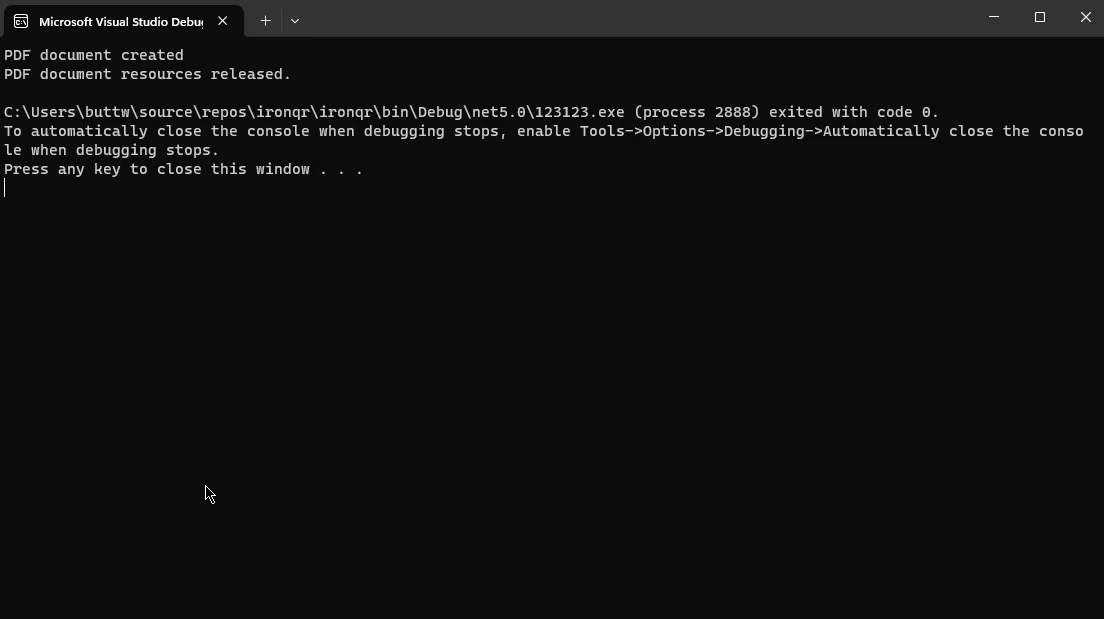Published December 25, 2023
C# Destructor (How it Works For Developers)
In the vast landscape of C# programming, the meticulous handling of memory resources stands as a cornerstone for the development of resilient and high-performing applications. At the heart of this imperative lies a pivotal feature— the destructor.
This article serves as a comprehensive exploration into the nuanced world of C# destructor, unraveling their intricacies by delving into their definition, elucidating their purpose, presenting illustrative examples, and elucidating the relevance of incorporating destructors into your codebase.
In the following code of this article we will discuss the destructors, its examples, and its uses. We will also discuss how to use the destructors with the PDF Library in C# named IronPDF.
1. What Are Destructors?
A destructor in the C# programming language is a specialized method designed to execute automatically when an object either goes out of scope or is explicitly set to null. This particular facet of C# holds immense significance, primarily revolving around the realm of resource management. Destructors, within their operational framework, empower developers to systematically release unmanaged resources, encompassing elements such as file handles, database connections, or network sockets.
Within the syntax of C#, the first base class destructor exhibits a distinctive structure, characterized by the presence of the tilde (~) symbol, immediately followed by the same name as the class name. This sets it apart from constructors in a fundamental way—destructors abstain from the inclusion of parameters, rendering their implementation remarkably straightforward and concise. This absence of parameters contributes to the simplicity and clarity of destructors and their integration into C# codebases.

1.1. Example of Destructors
Let's illustrate the concept of class destructors with a simple example. Consider a class named ResourceHandler that manages a file stream. The destructor in this case will be invoked automatically close the file stream when the object is no longer needed:
public class ResourceHandler
{
private FileStream fileStream;
// Constructor
public ResourceHandler(string filePath)
{
fileStream = new FileStream(filePath, FileMode.Open);
}
// Destructor
~ResourceHandler()
{
if (fileStream != null)
{
fileStream.Close();
Console.WriteLine("File stream closed.");
}
}
}public class ResourceHandler
{
private FileStream fileStream;
// Constructor
public ResourceHandler(string filePath)
{
fileStream = new FileStream(filePath, FileMode.Open);
}
// Destructor
~ResourceHandler()
{
if (fileStream != null)
{
fileStream.Close();
Console.WriteLine("File stream closed.");
}
}
}Public Class ResourceHandler
Private fileStream As FileStream
' Constructor
Public Sub New(ByVal filePath As String)
fileStream = New FileStream(filePath, FileMode.Open)
End Sub
' Destructor
Protected Overrides Sub Finalize()
If fileStream IsNot Nothing Then
fileStream.Close()
Console.WriteLine("File stream closed.")
End If
End Sub
End ClassIn this example, when an instance of ResourceHandler is created, a file stream is also created and opened. The destructor ensures that the file stream is closed when the object is garbage-collected.
2. When to Use Destructors
Destructors become particularly valuable when dealing with resources that are not managed by the garbage collector in the .NET runtime, such as file handles or database connections. While the garbage collection handles memory management for managed objects, it might not be aware of the specific cleanup requirements for unmanaged resources. Destructors bridge this gap, providing the garbage collector runs with a mechanism to release these resources explicitly.
It's important to note that C# developers often use the using statement in conjunction with objects that implement the IDisposable interface. This ensures timely and deterministic disposal of resources, making destructors less common in modern C# code. However, understanding destructors remains crucial for scenarios where direct resource management is necessary.
3. Introducing IronPDF in C#
IronPDF is a powerful library for working with PDFs in C#. It provides developers with a comprehensive set of tools to create, manipulate, and process PDF documents seamlessly within their C# applications. With IronPDF, developers can generate PDFs from various sources, including HTML, images, and other document formats.
This library simplifies the complexities of PDF handling, offering a user-friendly interface and a wide range of features, making it an excellent choice for C# developers seeking efficient and reliable PDF functionality in their applications. Now, let's delve into the world of C# destructors and explore how they can be effectively utilized, particularly in conjunction with IronPDF.
3.1. Utilizing C# Destructors with IronPDF
Let's explore a practical example of using C# destructors in conjunction with IronPDF to manage resources efficiently. Consider a scenario where you generate a PDF document and want to ensure that associated resources are released when the document is no longer needed.
using IronPdf;
using System;
public class PdfGenerator
{
private IronPdf.PdfDocument pdfDocument;
public void generate()
{
var renderer = new ChromePdfRenderer();
pdfDocument = renderer.RenderHtmlAsPdf("<p>This PDF is generated using IronPDF and Destructors.</p>");
pdfDocument.SaveAs("output.pdf");
Console.WriteLine("PDF document created ");
}
~PdfGenerator()
{
if (pdfDocument != null)
{
pdfDocument.Dispose();
Console.WriteLine("PDF document resources released.");
}
}
}
class Program
{
public static void Main()
{
PdfGenerator pdfGenerator = new PdfGenerator();
pdfGenerator.generate();
}
}using IronPdf;
using System;
public class PdfGenerator
{
private IronPdf.PdfDocument pdfDocument;
public void generate()
{
var renderer = new ChromePdfRenderer();
pdfDocument = renderer.RenderHtmlAsPdf("<p>This PDF is generated using IronPDF and Destructors.</p>");
pdfDocument.SaveAs("output.pdf");
Console.WriteLine("PDF document created ");
}
~PdfGenerator()
{
if (pdfDocument != null)
{
pdfDocument.Dispose();
Console.WriteLine("PDF document resources released.");
}
}
}
class Program
{
public static void Main()
{
PdfGenerator pdfGenerator = new PdfGenerator();
pdfGenerator.generate();
}
}Imports IronPdf
Imports System
Public Class PdfGenerator
Private pdfDocument As IronPdf.PdfDocument
Public Sub generate()
Dim renderer = New ChromePdfRenderer()
pdfDocument = renderer.RenderHtmlAsPdf("<p>This PDF is generated using IronPDF and Destructors.</p>")
pdfDocument.SaveAs("output.pdf")
Console.WriteLine("PDF document created ")
End Sub
Protected Overrides Sub Finalize()
If pdfDocument IsNot Nothing Then
pdfDocument.Dispose()
Console.WriteLine("PDF document resources released.")
End If
End Sub
End Class
Friend Class Program
Public Shared Sub Main()
Dim pdfGenerator As New PdfGenerator()
pdfGenerator.generate()
End Sub
End ClassThe above example C# code defines a PdfGenerator class responsible for creating PDF documents using IronPDF. The class encapsulates a private field, pdfDocument, which is an instance of IronPdf.PdfDocument. The generate method utilizes the ChromePdfRenderer to render HTML content into a PDF, in this case, a simple paragraph demonstrating the use of IronPDF and adherence to SOLID principles. The generated PDF is saved as "output.PDF," and a message is printed to the console indicating the successful creation of the document.
The class includes a destructor (~PdfGenerator()) that ensures garbage collector frees by disposing of the pdfDocument instance when the object is no longer in use. The accompanying Program class contains the main method, where an instance of PdfGenerator is created, and the generate method is called to produce the PDF document. The code exemplifies a basic implementation of PDF generation using IronPDF in a C# application, showcasing simplicity and adherence to good coding practices.
3.2. Output PDF

3.3. Console Output

4. Conclusion
In the dynamic landscape of C# programming, understanding memory management is indispensable for crafting efficient and reliable applications. Destructors offer a mechanism to explicitly release resources, for instance, making them a valuable tool in scenarios involving unmanaged resources.
While modern C# code often relies on the using statement and the IDisposable interface for resource management, destructors remain relevant for specific use cases. The integration of C# destructors with libraries like IronPDF exemplifies their practical application in real-world scenarios.
As you navigate the intricacies of C# development, consider the judicious use of destructors when dealing with unmanaged system resources, ensuring that your applications remain not only functional but also optimized in terms of system resource utilization.
IronPDF offers free trial to test the ability of IronPDF. To know more about HTML to PDF Conversion visit here.











